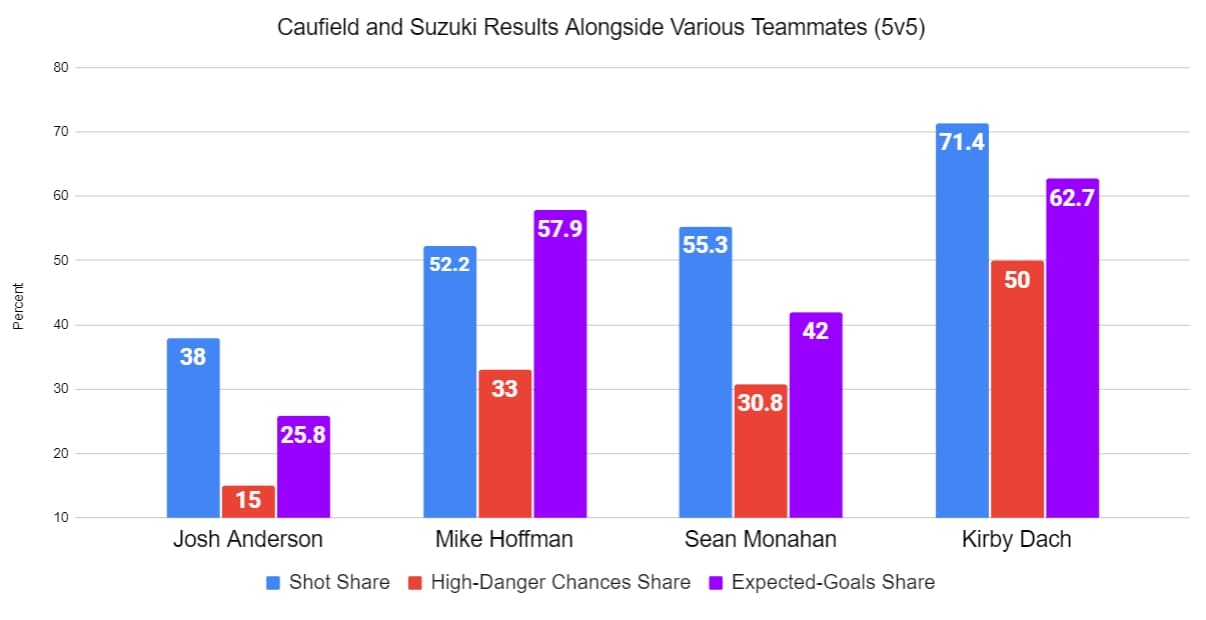Montreal Canadiens
Kirby Dach Showing Best Chemistry Alongside Caufield & Suzuki

Head coach Martin St-Louis has given four different players an opportunity to prove their worth on his top line: Mike Hoffman, Sean Monahan, Josh Anderson, and most recently, Kirby Dach.
Nick Suzuki and Cole Caufield‘s chemistry has been the most exciting storyline of the Montreal Canadiens’ rebuild, but the question remains, who should complete the offensively-talented duo?
And while Caufield and Suzuki have given us ample evidence that they can score goals alongside any given winger, there has been a significant difference in the impact the aforementioned wingers have made on the pair.
Remember, scoring goals is always important, but the process itself is just as important, as it tends to reveal whether the production is sustainable.
Caufield and Suzuki possess the type of raw talent that can maintain a relatively healthy goal different while being outplayed, though you’d be hard-pressed to call that type of situation ideal.
Failed Experiment
For example, when the speedy Anderson was added to the line, they scored goals at 5v5, however, they struggled to control the play, both when it came to generating shots and high-danger scoring chances.
With Anderson on their wing, Suzuki and Caufield only had a 38 percent share of the overall shots, as well as 25 percent of the quality opportunities, generating only 2 high-danger chances while allowing 11 against.
Their expected goals (xGF%) ended up being a paltry 25 percent, which isn’t just below replacement, it’s a complete disaster for any team’s top line.
Anderson’s style of play, which generally focus strictly on a north-south offence which generates chances off the rush, clearly does not mesh with Caufield and Suzuki’s penchant for generating chances off the cycle and opening up passing lanes with sustained pressure in the offensive zone.
Getting Closer
It may come as a surprise to some, but Mike Hoffman’s very brief time on the top line was a relatively successful audition.
Together, the trio controlled the majority of the shots (52.1 percent) and they managed to score a single goal while shutting their opponents out, but once again there was a red flag when evaluating the scoring chances.
They played a little under 12 minutes at 5v5 together, but in that time, they only managed 2 scoring chances while allowing 9, similar to the results when Anderson was used.
Despite their difficulty when it came to generating good scoring chances, the line finished with a positive expected goals share (57 percent).
It was an experiment that yielded better results than the previous test, but given Hoffman’s somewhat tumultuous status in Montreal, it was quickly put to an end and is unlikely to be repeated.
Almost There
Monahan’s tenure beside Suzuki and Caufield was a familiar story. The line controlled the overall shots (55.3 percent) but once again struggled when it came to mastering the art of having an advantage in quality scoring chances.
They scored 4 goals while allowing 3 against, but it was driven by raw talent rather than sustainability.
In total, they only had 4 high-danger chances while allowing 9 against, which resulted in a paltry 42 percent expected goals share. (xGF%)
This One Is Juuuuuuuust Right
The last, and most exciting development has been the addition of a 21-year-old centre Kirby Dach to the line.
His numbers alongside Caufield and Suzuki aren’t just good in a few key categories, they point to instant chemistry and the most important aspect in hockey: sustainability.
With Dach on the line, they controlled the shots (71.4 percent), the goals (66 percent), and the scoring chances (61.5 percent). Consequently, the trio held an impressive 62.8 percent share of the expected goals.
Their share of the high-danger chances is even, at 50 percent, though that is a major improvement upon the results with various other players.
Here’s what the numbers look like when placed side by side, it gives you a better idea of how much the process improved once Dach was used.

As you can see, not only did Dach produce better numbers alongside Caufield and Suzuki, he pushed them to the point that the overall process indicates a strong probability of long-term sustainability, owing to his penchant for generating controlled entries, and his ability to create open ice for his linemates.
Coucou, c'est Cole. 🌚#GoHabsGo pic.twitter.com/GMQx9wXsA3
— Canadiens Montréal (@CanadiensMTL) October 30, 2022
Of course, there are other factors to consider.
First off, we’re dealing with very limited ice time given the season is still in its infancy.
Secondly, Dach won’t improve his faceoff skills while playing on the wing, and there’s also the matter of spreading the offensive wealth throughout the lineup rather than stacking it on a single line.
But any way you cut it, there’s no denying that the early results indicate Kirby Dach is far and away the best fit on the top line.
He’s the only player who significantly improved the overall process.
(All statistics are 5v5 unless otherwise noted, via NaturalStatTrick)









